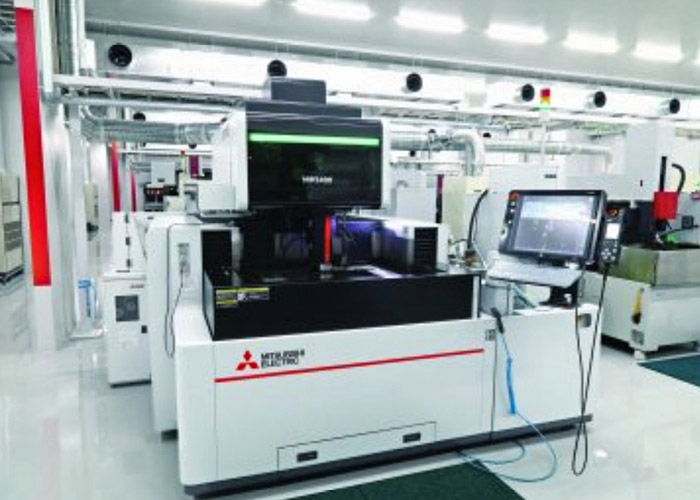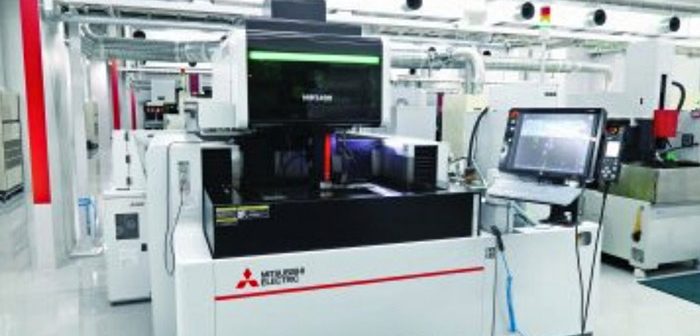
Japanese electronic component and automotive parts manufacturer I-PEX has replaced manual grinding activities with a numerical controlled (NC) wire electro-discharge grinding (WEDG) process at its Ogori City die manufacturing site. The company says this will improve product quality and throughput while reducing the number of repetitive tasks for operators.
I-PEX also says they can now have automated operations running overnight, reducing the workload and overtime demands on operators. They say the new process has reduced machining errors and increased the operating rate by approximately 20%, and work that would typically take three days now takes two days.
I-PEX installed Mitsubishi Electric’s MP2400 ultra-high precision wire EDM machine to replace manual grinding activities.
“About a third of the die manufacturing process relies on Mitsubishi Electric’s technologies,” says I-PEX’s Hajime Kuga. “We heard from Mitsubishi Electric that the MP2400 can reduce the phenomenon of the softening of the machining surface after wire electrolysis to almost zero. After a sample processing test, we got the results we wanted, so we decided to go with this machine.”
The softening of the eroded surface layer of the workpiece, a form of electrolytic corrosion, occurs due to the interaction of the processing fluid, deionized water, and the direct current used for cutting. However, in the case of the MP2400, electrolysis-free machining is achieved by a high-speed anti-electrolysis power supply.
The MP2400 has improved the performance of automatic threading of the cutting wire, and this has decreased errors during machining. “Depending on the shape of the piece being worked, it may take more time than machining with a grinder, but the MP2400 can operate unattended overnight, reducing the workload on the operator and potential requirement for overtime,” said Kuga.
In 2020, the company installed a new SV12PM machine, Mitsubishi Electric’s ultra-high-precision die-sinking EDM. The goal was to increase productivity in manufacturing large dies for automotive parts. “We installed this system based on our in-house findings, indicating that the larger the machining area, the greater the reduction in machining time,” adds Kuga. “While this depends on the size of the die and what is being machined, in our plant, work that took three days to complete with conventional equipment can now be accomplished in two days, which is a great benefit.”
The MP2400 and SV12PM utilise Mitsubishi Electric’s iQ Care Remote4U for remote monitoring of operating status and errors. The IPEX team intends to continue automating the die manufacturing processes through the utilisation of new equipment and services.
The close relationship with Mitsubishi Electric is supporting I-PEX’s overall growth strategy. “We plan to leverage key opportunities, such as technology roundtable meetings with Mitsubishi Electric, to improve our core technical capabilities and, at the same time, promote transformation in both our operations and business model,” said I-PEX Electronic Components Division Managing Officer Akihiko Hara. “While continuing to grow our existing core business of manufacturing electronic and automotive components, we want to expand into new areas, such as the production of piezoelectric MEMS devices that utilise single-crystal films, photoelectric connectors that are crucial for future data centres and telecommunication base stations, as well as healthcare and DNA analysis equipment.” has replaced manual grinding activities with a numerical controlled (NC) wire electro-discharge grinding (WEDG) process at its Ogori City die manufacturing site. The company says this will improve product quality and throughput while reducing the number of repetitive tasks for operators.
I-PEX also says they can now have automated operations running overnight, reducing the workload and overtime demands on operators. They say the new process has reduced machining errors and increased the operating rate by approximately 20%, and work that would typically take three days now takes two days.
I-PEX installed Mitsubishi Electric’s MP2400 ultra-high precision wire EDM machine to replace manual grinding activities.
“About a third of the die manufacturing process relies on Mitsubishi Electric’s technologies,” says I-PEX’s Hajime Kuga. “We heard from Mitsubishi Electric that the MP2400 can reduce the phenomenon of the softening of the machining surface after wire electrolysis to almost zero. After a sample processing test, we got the results we wanted, so we decided to go with this machine.”
The softening of the eroded surface layer of the workpiece, a form of electrolytic corrosion, occurs due to the interaction of the processing fluid, deionized water, and the direct current used for cutting. However, in the case of the MP2400, electrolysis-free machining is achieved by a high-speed anti-electrolysis power supply.
The MP2400 has improved the performance of automatic threading of the cutting wire, and this has decreased errors during machining. “Depending on the shape of the piece being worked, it may take more time than machining with a grinder, but the MP2400 can operate unattended overnight, reducing the workload on the operator and potential requirement for overtime,” said Kuga.
In 2020, the company installed a new SV12PM machine, Mitsubishi Electric’s ultra-high-precision die-sinking EDM. The goal was to increase productivity in manufacturing large dies for automotive parts. “We installed this system based on our in-house findings, indicating that the larger the machining area, the greater the reduction in machining time,” adds Kuga. “While this depends on the size of the die and what is being machined, in our plant, work that took three days to complete with conventional equipment can now be accomplished in two days, which is a great benefit.”
The MP2400 and SV12PM utilise Mitsubishi Electric’s iQ Care Remote4U for remote monitoring of operating status and errors. The IPEX team intends to continue automating the die manufacturing processes through the utilisation of new equipment and services.
The close relationship with Mitsubishi Electric is supporting I-PEX’s overall growth strategy. “We plan to leverage key opportunities, such as technology roundtable meetings with Mitsubishi Electric, to improve our core technical capabilities and, at the same time, promote transformation in both our operations and business model,” said I-PEX Electronic Components Division Managing Officer Akihiko Hara. “While continuing to grow our existing core business of manufacturing electronic and automotive components, we want to expand into new areas, such as the production of piezoelectric MEMS devices that utilise single-crystal films, photoelectric connectors that are crucial for future data centres and telecommunication base stations, as well as healthcare and DNA analysis equipment.”






